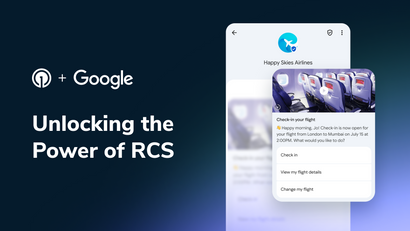Ah, the thrill of launching a sleek, carefully constructed journey. The copy is tight, the design is on point, and the timing is based on campaign best practices. And yet... crickets.
You’re not alone. Many polished mobile journeys underperform, not because the audience is wrong, but because one critical factor is ignored: what the audience is actually doing (or not doing.)
Learning how to leverage mobile user behavior is the missing ingredient in most mobile journeys, and properly wrapping your head around it will lead to higher conversions, better user retention, and smarter campaigns with less manual work.
Why great mobile journeys still fall short
Marketers today are under massive pressure to deliver hyper-personalized experiences across multiple channels (push, in-app, email, SMS/RCS, Live Activities) all while juggling limited resources and even less time.
You’ve got a funnel, a high-level strategy, and maybe even an omnichannel journey builder. But if your campaigns don’t adjust to what users are doing in real time, you're flying blind.

Users don’t behave in neat, linear ways. They abandon carts. They scroll without tapping. They revisit a pricing page three times and still don’t convert. Static campaigns simply can’t keep up with that complexity.
And when you can’t adapt in the moment, here’s what happens:
- Your welcome flow keeps firing, even after the user’s already made a purchase. It feels out of sync, wastes a touchpoint, and undermines the experience.
- You launch a campaign promoting a feature the user already tried and didn’t find helpful. Instead of feeling personalized, it feels like you weren’t paying attention.
- Re-engagement messages land long after the user has already churned. The window to win them back closes, and the effort is wasted.
- You build journeys based on assumptions, not behavior. And you’re left wondering why the results aren’t matching the strategy.
- You rely on engineering to manually pull behavioral segments, delaying campaigns by days or weeks. By the time it goes live, the user’s context has changed.
- Messages get ignored because they don’t feel timely or relevant. Engagement drops, and what could have been a high-converting moment turns into noise.
What do we mean when we say “behavioral signals?”
“Behavioral signals” can sound like a buzzword (and they’re often used that way) but they’re actually the most concrete insights you have into user intent.
Companies using real-time behavioral data in their customer strategies see 62% higher revenue growth and 97% higher profit margins, according to MIT research.
Some of the most common and useful behavioral signals include:
- Clicks on specific features or content
- Scroll depth on key screens or landing pages
- Add-to-cart events without a purchase
- Search queries with no results
- Drop-offs at key points in onboarding
- Repeat visits to product pages
- Abandoned signups
- Video watch time or interactions
You should be treating these moments like reading digital body language. They give you a real-time pulse on what users care about, where they’re confused, and what might nudge them toward conversion.
From insight to action: Closing the loop
Unfortunately, this is where most teams hit a wall.
They have behavioral data—in a CDP, a warehouse, or buried in analytics dashboards. But they can’t act on it easily in their mobile messaging tool.
What happens next is an all-too-common bottleneck:
- The marketing team identifies a behavioral opportunity (e.g., users who added to cart but didn’t buy).
- They submit a request to engineering to pull the data and prep a CSV.
- Days (or weeks) later, the static segment gets uploaded to their engagement platform.
- The moment has passed, and the campaign misses its mark.
Not only is this process slow and error-prone, but it also forces marketers to work with outdated, rigid data. There’s no flexibility to test, iterate, or personalize in real time.
Behavioral insights only drive results when you can respond to them in the moment while intent is high and the window of opportunity is still open.
Simple ways to start using mobile user behavior today
Even without complex infrastructure or tools, there are a few ways you can start incorporating behavioral signals into your messaging strategy right now.
1. Track drop-off points
Use basic analytics to identify where users tend to fall off in key flows (like onboarding, checkout, or sign-up) and set up simple re-engagement messages at those moments.
🟢 Example: If most users abandon sign-up at step 3, trigger a reminder email or push notification an hour later with a friendly nudge and a value prop.
2. Create micro-segments
Group users based on meaningful behaviors, even if it’s manual at first.
🟢 Example: Create a segment of users who viewed your pricing page 3+ times in a week. These are high-intent users who may need a well-timed incentive or helpful content to convert.
3. Trigger based on inactivity
Don’t just look at what users do, look at what they don’t do. Inactivity is a signal too.
🟢 Example: If a user hasn’t opened your app in 7 days after completing onboarding, send a message with a compelling reason to come back (exclusive content, limited offer, new feature, etc.).
4. Use on-site behavior for follow-ups
Website tools like Google Analytics or Hotjar can show where users click, scroll, or stall. Use these insights to inform message timing or content.
🟢 Example: If a user watches 90% of your product video but doesn’t sign up, follow up with social proof or an incentive to try it out.
5. Personalize copy based on past behavior
Even without dynamic data injection, you can tailor messages to reflect what users have shown interest in.
🟢 Example: “Since you checked out our budgeting tools last week, here’s a quick guide to get the most out of them.”
Why this matters more than ever
Today’s consumers expect brands to understand them, and not just demographically. They want communication that feels responsive, contextual, and relevant to what they’re experiencing right now!
When you tap into real-time behavior:
🔥 Conversion rates increase: You catch users when intent is highest.
🔁 Retention improves: Personalized nudges bring users back before they churn.
💰 LTV grows: Relevant upsells and re-engagement drive revenue over time.
🧠 Marketing gets smarter: You learn what works and can iterate faster.
The bottom line
Even the most refined journeys fall flat when they ignore what users are doing in the moment. Behavioral signals are the missing ingredient that transforms good campaigns into great ones.
We suggest starting small. Watch where users drop off, personalize based on actions, and use inactivity as a clue. These are simple shifts that add up to meaningful improvements in engagement, retention, and ROI.
The future of messaging is responsive, real-time, and radically personal.
Ready to build smarter, more behavior-driven journeys?
Get Started for Free



